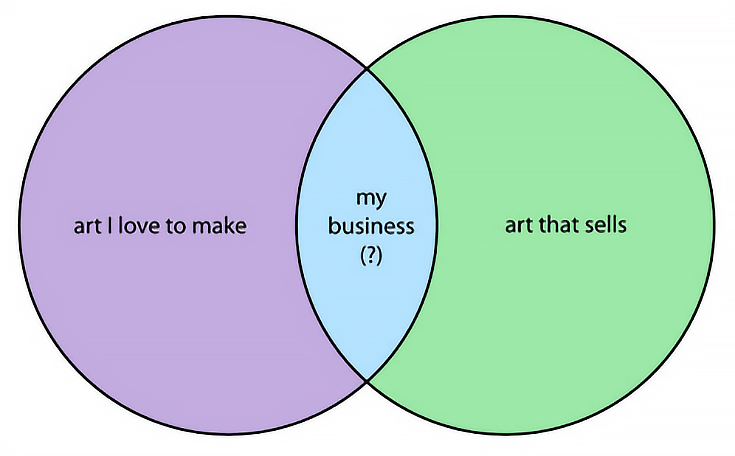The writer Steven Pressfield, author of The Legend of Bagger Vance, recently shared in a blog post how he developed his business model. He drew two circles on a piece of paper, labeling one “Stories I love” and the other “Stories that might sell.” Where they overlapped, he labeled it “My Business.”
He said to himself:
“Steve, focus all your effort in that little overlap and don’t ever go outside it. Don’t work on stuff you love that you believe is totally uncommercial. And don’t work on projects that you imagine will sell but that you hate. Stick to the sweet spot.”
It sounds like a logical and sound business practice: find the sweet spot between making what you love and making what will sell, and build your business around that overlap. Brilliant! And it should work, right? Seemingly, no.
Pressfield explains further:
“Here’s the interesting part: it didn’t work. . . nothing really clicked for me until I gave up completely on hitting the overlap and just did what I loved, even when I thought nobody else in the world would be interested.”
I’ve found the same thing to be true in my art career. I’m drawn to creating very abstract images, photographs that make you question what you are seeing. Yet my more representational pieces—photographs that are obviously of a flower or a leaf—seem to sell better.
Logically, then, I should limit my abstract work and focus more on those representational photographs. Yet this method tends to backfire. My work stalls, my creativity dries up, and I find myself neither making work nor selling.
After thinking about this for a while, I realized that there are a couple fundamental flaws with trying to build a business in the sweet spot between your passion and marketability:
First, it assumes that you can predict what will sell. And second, it assumes you can control your creativity.
Predicting what will sell based on what has sold in the past is tricky, if not impossible. You may think you know why one type of art is selling better, but the truth is, you probably don’t. You could just be unintentionally marketing one type of art differently. Maybe you’ve been promoting it longer, or it just found its audience faster. Or maybe those works are just easier to market online. (For example, it is much easier to describe a representational work for Google than an abstract one.)
You could be completely wrong about why your best sellers are your best sellers.
I assume my representational photographs sell better because they are easier to understand and appreciate, but I could be wrong. Maybe the photographs that sell better have nothing to do with abstraction vs representational. Maybe it’s the colors I am using in that series, or the subject matter, or the technique.
Or maybe there is no real pattern at all to what sells vs what doesn’t—I mean, it’s not like I’m selling on a scale that makes any statistical analysis very valid.
Since it is so difficult to accurately predict what will sell and why, constraining what I create based on my best-guesses is foolish at best. And when I assume that I know why these pieces are selling, I may overlook other qualities in my art that are attracting collectors.
I may think I’m being market-savvy, while just shutting out my next big seller.
Likewise, it is foolish to assume that I can control my creativity. If I say, “Ah, this type of art is selling so that’s all I’ll make,” I am profoundly misunderstanding my own creative process.
My creativity is NOT a machine that can be tuned to a certain profitable frequency and switched on. No, it is messy, chaotic, and exploratory.
My creativity needs to experience some sort of freedom in order to function. Trying to limit my output to a certain style would quickly dampen my ability to create anything.
This is one of my ‘crazy’ abstract photographs, of tree bark (if you couldn’t tell).
I also believe that one of the reasons my simpler pieces sell better is because they are influenced by my crazier work. They may feel “simpler” to me, but they have gained a higher degree of sophistication from the techniques and ideas I have learned by exploring the creative fringes.
Without my more abstract work, my representational work would probably be flatter, more boring, more predictable. My passion is in the abstract, and I believe that you can feel this passion in all of my work.
If I prevented myself from doing this style of art for the sake of my business plan, my passion would diminish, and ALL of my work would suffer.
So like Pressfield, I have come to realize that trying to base my creation of art on the market is not the right path for me. Maybe my balance is not in the middle between passion and commerce. Maybe the best business model is to pursue my passion and throw all of my energy into discovering what makes my art unique.
These pieces may never gain a big enough market share to make money, but hopefully their quality and energy will fuel the reputation for the rest of my work.
At the same time, I should continue to pay attention to what is selling, as long as I don’t try to chase it. I will use my sales as a litmus test for what may be connecting with an audience, and then learn from that connection and try to extend that knowledge to all of my work.
Hopefully by following my passion, while still listening to the market, I can find a business model that works for me—and still make a living in this crazy industry.
Read more at Daniel Sroka’s blog or check out his abstract nature photography.
This post may contain affiliate links.


